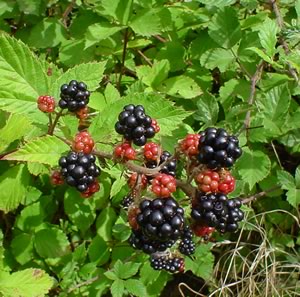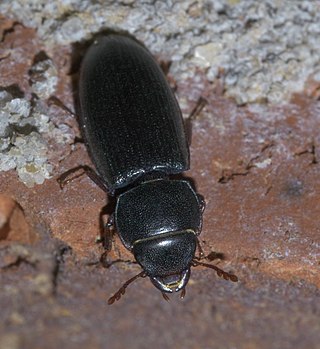
Rubus is a large and diverse genus of flowering plants in the rose family, Rosaceae, subfamily Rosoideae, with over 1,350 species, commonly known as brambles.

Cleroidea is a small superfamily of beetles containing over 10,000 species. Most of the members of the group are somewhat slender, often with fairly soft, flexible elytra, and typically hairy or scaly.

The Turtle Mountains, are located in northeastern San Bernardino County, in the southeastern part of California. The colorful Turtle Mountains vary from deep reds, browns, tans and grays, to black. The area has numerous springs and seeps. The Turtle Mountains are also a National Natural Landmark, with two mountain sections of entirely different composition.

Pseudotephritis is a genus of picture-winged flies in the family Ulidiidae.

Pseudotephritis corticalis is a species of picture-winged fly in the genus Pseudotephritis of the family Ulidiidae

Trogossitidae, also known as bark-gnawing beetles, are a small family in the superfamily Cleroidea. Many taxa formerly within this family have been removed to other families, such as Lophocateridae, Peltidae, Protopeltidae, Rentoniidae, and Thymalidae. Members of the family are generally predatory and/or feed on fungi, both in adult and larval stages, and are generally associated with wood, being found under bark or inside bored tunnel galleries. There are about 400 species in 25 genera in the family under the new, restricted circumscription, as opposed to 600 species in over 50 genera in the old definition. The oldest fossil assignable to the modern, more restricted definition of the family is Microtrogossita from the mid-Cretaceous Burmese amber of Myanmar, which has close affinities to the Trogossitini, indicating that the family had already considerably diversified by this time.

Clubiona corticalis, the bark sac spider, is a species of spider belonging to the family Clubionidae.
Armatimonadota is a phylum of gram-negative bacteria.

Hypotia corticalis is a species of snout moth in the genus Hypotia. It was described by Michael Denis and Ignaz Schiffermüller in 1775 and is known from France, Spain, Portugal, Italy, Croatia, Greece, Sardinia, Corsica, Sicily, Crete and the Canary Islands.

Temnoscheila is a genus of bark-gnawing beetles in the family Trogossitidae, historically often misspelled as "Temnochila". There are about 19 described species in Temnoscheila.

Tenebroides americanus is a species of bark-gnawing beetle in the family Trogossitidae.

Tenebroides is a genus of bark-gnawing beetles in the family Trogossitidae. There are at least 20 described species in Tenebroides.

Tenebroides laticollis is a species of bark-gnawing beetle in the family Trogossitidae.
Micromimus is a genus of true weevils in the beetle family Curculionidae. There are about 18 described species in Micromimus.
Stenomimus is a genus of true weevils in the beetle family Curculionidae. There are more than 30 described species in Stenomimus.
Patapius is a genus of spiny-legged bugs in the family Leptopodidae. There are about seven described species in Patapius.
Temnothorax corticalis is a species of ant belonging to the family Formicidae.

Calitys is a genus of beetles belonging to the family Trogossitidae. It is the only member of the subfamily Calityinae. The genus was first described by Thomson in 1859. The genus contains two unambiguous species Calitys scabra, which is native to Europe and North America, and Calitys minor, which is native to North America. Some species have been reported from South Africa, but these are disputed. The two unambiguous species live on and under the bark of coniferous trees, where they feed on fungi.

Temnoscheila chlorodia, also called the green bark-gnawing beetle or green bark beetle, is a species of bark-gnawing beetle. It is found in North America west of the Great Plains.

Rentoniidae is a family of beetles belonging to Cleroidea. The species were originally included in the family Trogossitidae. They are around 1–2 mm in length, with spherical bodies. Members of the family are native to the Southern Hemisphere, being found in Australia, New Zealand, New Caledonia and South America. They have been found on flowers, under the bark of dead trees, and in leaf litter, and members are known to be pollenivorous or fungivorous.















